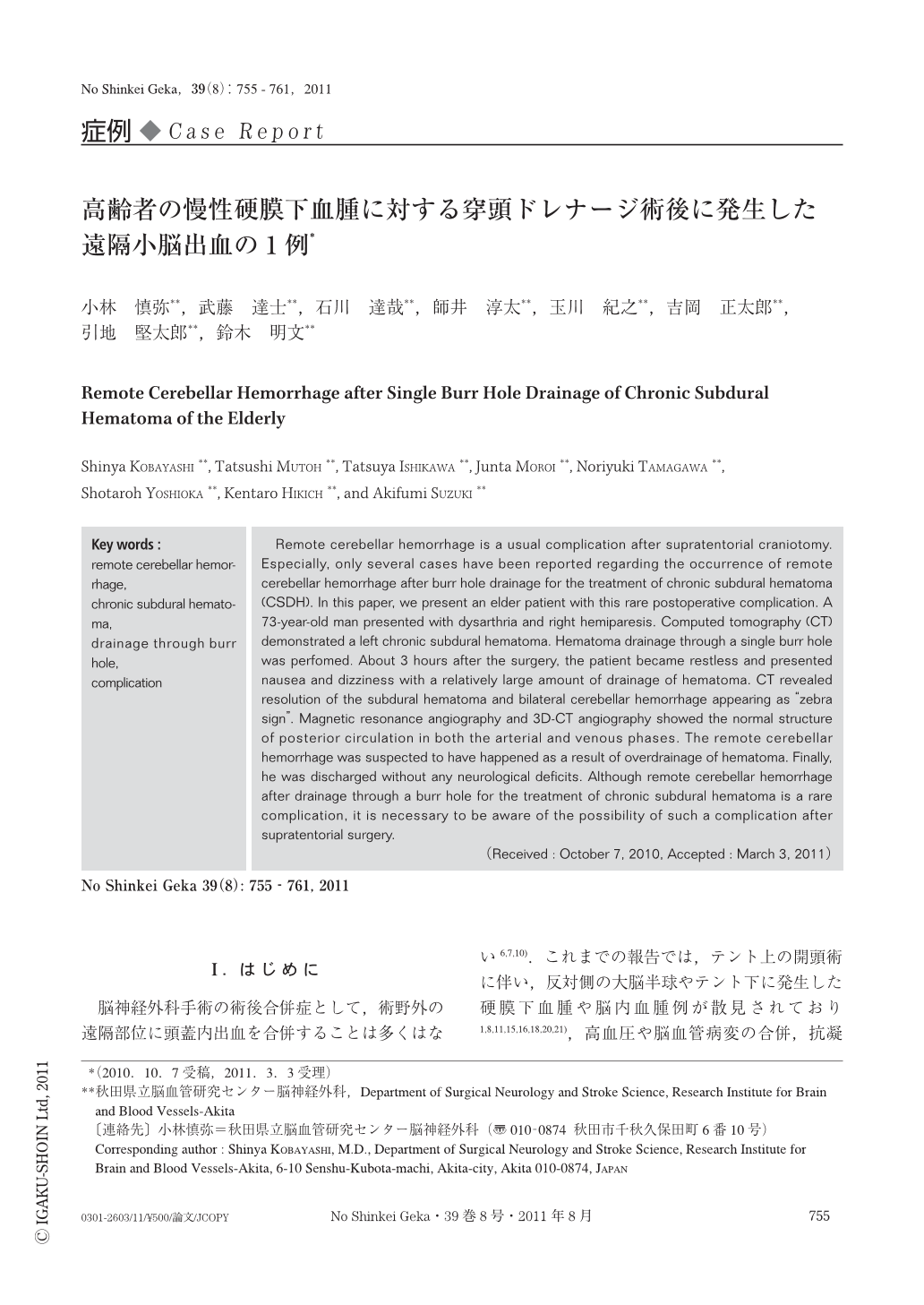Japanese
English
- 有料閲覧
- Abstract 文献概要
- 1ページ目 Look Inside
- 参考文献 Reference
Ⅰ.はじめに
脳神経外科手術の術後合併症として,術野外の遠隔部位に頭蓋内出血を合併することは多くはない6,7,10).これまでの報告では,テント上の開頭術に伴い,反対側の大脳半球やテント下に発生した硬膜下血腫や脳内血腫例が散見されており1,8,11,15,16,18,20,21),高血圧や脳血管病変の合併,抗凝固・抗血小板療法などの条件下での術中の急激な減圧による脳の架橋静脈の破綻が誘因の1つとして推定されているが12-14,27),その確実な病因は不明である.こうした遠隔出血の頻度は非常に低いものの,一度発症すると患者の予後に重大な影響を及ぼしかねない9).また症候としては頭蓋内圧亢進症状が一般的であり,早期発見に役立つが,高齢者に発生した場合は,潜在する脳萎縮により頭蓋内圧亢進症状は少なく,一見して術後不穏や血腫減圧に伴う一過性の低脳圧症状と見誤る危険もあるため注意が必要である.さらに最近では,こうした病態がより低侵襲な治療手技である慢性硬膜下血腫の穿頭術にも起こり得るとの警告もある2,5,23).
今回われわれは,高齢者においてテント上慢性硬膜下血腫の穿頭術後に発症した遠隔小脳出血を経験したので,各種検査上の知見と病態を検討し,文献的考察を加えて報告する.
Remote cerebellar hemorrhage is a usual complication after supratentorial craniotomy. Especially,only several cases have been reported regarding the occurrence of remote cerebellar hemorrhage after burr hole drainage for the treatment of chronic subdural hematoma (CSDH). In this paper,we present an elder patient with this rare postoperative complication. A 73-year-old man presented with dysarthria and right hemiparesis. Computed tomography (CT) demonstrated a left chronic subdural hematoma. Hematoma drainage through a single burr hole was perfomed. About 3 hours after the surgery,the patient became restless and presented nausea and dizziness with a relatively large amount of drainage of hematoma. CT revealed resolution of the subdural hematoma and bilateral cerebellar hemorrhage appearing as “zebra sign”. Magnetic resonance angiography and 3D-CT angiography showed the normal structure of posterior circulation in both the arterial and venous phases. The remote cerebellar hemorrhage was suspected to have happened as a result of overdrainage of hematoma. Finally,he was discharged without any neurological deficits. Although remote cerebellar hemorrhage after drainage through a burr hole for the treatment of chronic subdural hematoma is a rare complication,it is necessary to be aware of the possibility of such a complication after supratentorial surgery.

Copyright © 2011, Igaku-Shoin Ltd. All rights reserved.


